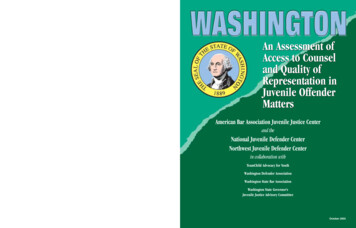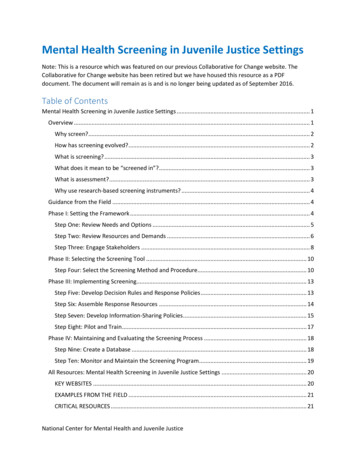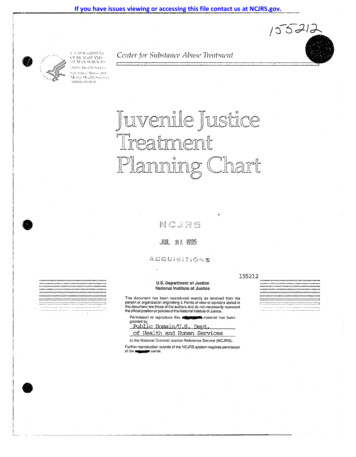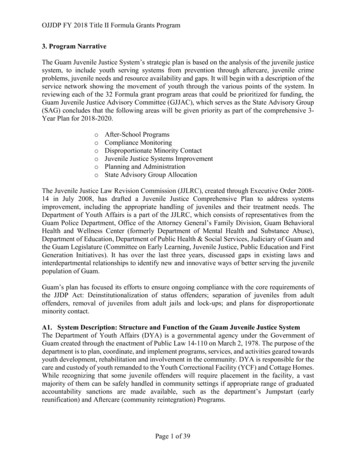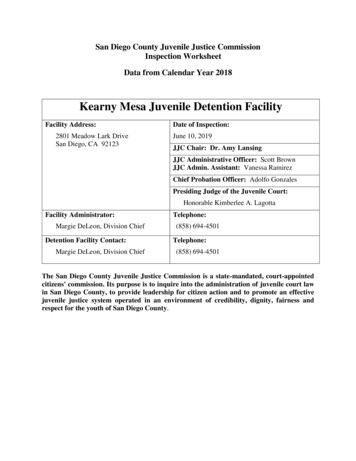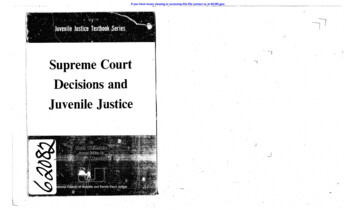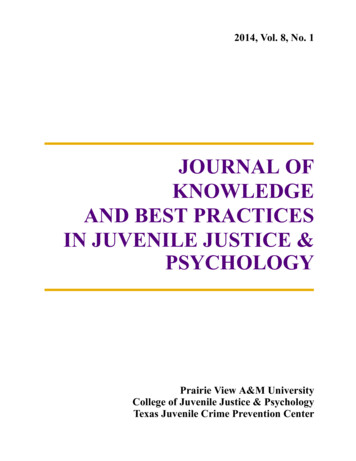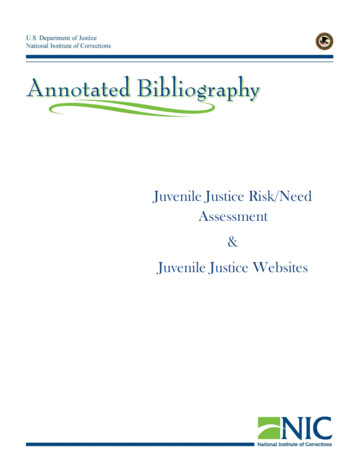
Transcription
Juvenile Justice Risk/NeedAssessment&Juvenile Justice Websites1
Juvenile Justice Risk/Need Assessment & Juvenile JusticeWebsites Annotated BibliographyPrepared by the NIC Information CenterSeptember 2013Accession No. 027615An electronic copy of this document can be found at: nicic.gov/Library/027615ContentsJuvenile Assessment . 3Assessment Tools . 14Juvenile Justice: Websites. 152
Juvenile AssessmentBaglivio, Michael T. “The Assessment of Risk to Recidivate Among a Juvenile Offending Population.”Journal of Criminal Justice 37, no. 6 (2009): 596-607.The Florida Department of Juvenile Justice has implemented a new fourth-generation risk/needassessment to assess the risk to re-offend for juveniles referred to the department. The newassessment, the Positive Achievement Change Tool, or PACT, is adapted from the validatedWashington State Juvenile Court Assessment, on which the Youth Assessment ScreeningInventory (YASI) was also modeled. This study validated the PACT assessment, and examinedwhether the instrument is as predictive of female delinquency as it is of male delinquency,utilizing subsequent official delinquency referral as the dependent measure. Gender differenceswere explored and illustrated the instrument to be effective in predicting female and maledelinquency, yet the factors predicting female delinquency did not mimic those predictive ofmale delinquency. Furthermore, for both male and female juveniles, a score of environmentaland personal characteristics and situations had a stronger relationship with recidivism than did ascore of official criminal history.Baglivio, Michael T., and Katherine Jackowski. “Examining the Validity of a Juvenile Offending RiskAssessment Instrument across Gender and Race/Ethnicity.” Youth Violence & Juvenile Justice 11, no. 1(2013): 26-43.Analysis of predictive validity of the risk/needs assessment used by a criminal justice agency isparamount. The validity of the Positive Achievement Change Tool (PACT) acrossgender/race/ethnicity in a juvenile sample was examined. Results demonstrate recidivismincreases as PACT score increases, with minor exceptions. Findings suggest similar prediction ofreferral/arrest and adjudication/conviction across subgroups. 95% confidence intervalsoverlapped for all subgroups on 13 of 19 measures examined. However, which factors predictrecidivism across subgroups differ. Criminal history was the most prevalent predictor, while nofactor predicted White female offending. “Gender-responsive” item inclusion measuringabusive/traumatic circumstances did not improve prediction.Bechtel, Kristin, Christopher T. Lowenkamp, and Edward Latessa. “Assessing the Risk of Re-Offending ofJuvenile Offending for Juvenile Offenders Using the Youth Level of Service/Case ManagementInventory.” Journal of Offender Rehabilitation 45, no. 3/4 (2007): 85-108.The purpose of the Youth Level of Service Case Management Inventory (YLS/CMI) is to assess,classify, and assist agencies with developing treatment and service plans according to theoffender’s criminogenic risk factors. Given the limited research in the predictive validity for thisinstrument, the current study attempts to examine this issue on a sample of 4,482 juvenilesfrom Ohio who were given sentences in the community or to juvenile institutions. Resultsdemonstrated the validity of the YLS/CMI in predicting recidivism for both s/articles/Risk of Reoffending YLSCMI.pdfBenner, Gregory J., Scott A. Stage, Ron J. Nelson, Mike Laederich, and Nicole C. Ralston. “Predicting theCumulative Recidivism of Juvenile Detainees.” Journal of Behavior Analysis of Offender & Victim:Treatment & Prevention 2, no. 1 (2010): 51-62.The primary purpose of this research was to identify the most robust set of factors contributingto the recidivism of juvenile detainees; including demographic, court history, mental health,substance abuse, and maltreatment variables. Recidivism in this paper is defined as havingreceived more than one status offense or non-status offense. Status offenses are incurred3
because of the prohibition of various acts due to the offender's status as a juvenile (e.g., alcoholconsumption, violation of curfew, or truancy). Non-status offenses (i.e., delinquency) areincurred because of violation of the law and commitment of a crime. The study populationincluded 761 juvenile offenders in the Northwest. Juveniles who had a history of childhoodmaltreatment, above average use of alcohol/drugs, and experienced traumatic experienceswere four times (4.22 odds ratio) more likely to have repeated juvenile status offenses. Further,sex and suicide ideation increased the likelihood of committed repeated non-status offenses by6.5 times. Findings, limitations, and implications are discussed. [ABSTRACT FROM AUTHOR]Chambers, Benjamin. Doing it Right: Risk Assessment in Juvenile Justice – An NJJN Webinar.Presenter: Gina Vincent, PhD, Co-Director of the National Youth Screening & n-njjn-webinarClayton, John. “Washington's Journey with Evidence-Based and Research-Based Programs in JuvenileJustice.” Policy & Practice 70, no. 3 (2012): 20-22.The article focuses on evidence-based and research-based programs that are part of juvenilejustice in Washington and finding cost effective programs to reduce recidivism among juvenileoffenders. The U.S. Community Juvenile Accountability Act (CJAA) was passed by theWashington State Legislature to check if the programs reduce repeat offenses by juvenileoffenders. A system of risk assessment has been implemented by county juvenile courts toidentify levels of risk and eligibility of youths.Dolan, Mairead, Troy E. McEwan, Rebekah Doley, and Katarina Fritzon. “Risk Factors and RiskAssessment in Juvenile Fire-Setting.” Psychiatry, Psychology & Law 18, no. 3 (2011): 378-394.This article provides an overview of the literature on risk issues in juvenile fire-setting behaviour.In particular, we highlight the importance of acknowledging the differences in terminology usedin current studies and outline the importance of developmental issues in understanding whenfire-related activities should be considered pathological. The estimated prevalence of fireinterest, fire play, fire-setting and arson are discussed. The key sociodemographic, individualand environmental factors that are associated with pathological fire-setting are discussed in thecontext of general delinquency. The limited findings, to date, suggest that fire-setting in themain is similar to non-fire-setting delinquent behaviour in juveniles as the majority have conductdisorder rather than major mental illness. There is some very limited evidence that attentionalproblems may have a specific association with fire-setting but this requires replication on alarger scale. Risk assessment for those who have engaged in fire-setting behaviour iscontextualised within the model outlined in the United States Federal Emergency ManagementAgency (FEMA) as this is one of the leading international agencies conducting work in this field.A variety of available risk assessment tools are outlined and the utility of FEMA models andscreening tools for assigning cases to appropriate risk assessment-based interventions isoutlined. Additional clinically based tools are discussed and their value in treatment/management assignment decisions is highlighted. Using a risk model for fire-setting, it is clearthat multiagency working is crucial in designating cases to higher levels of multi-disciplinaryassessment and treatment. At present, current international and Australian interventions forjuveniles largely focus on educational and fire safety awareness programmes and there is a lackof structured clinically based programmes that meet the needs of those higher-risk juvenileswho have unmet mental health and social needs. [ABSTRACT FROM AUTHOR]4
Edinburgh, Laurel. “The 10-Question Tool: A Novel Screening Instrument for Runaway Youth. OJJDPJournal of Juvenile Justice 1, no. 2 (2011): 80-94.Adolescents who run away face high rates of sexual and physical assault, yet there are noestablished brief screening tools that police can use to determine adolescents’ safety or thathelp police refer such youth to needed services when they are located. We developed the 10Question Tool for law enforcement officers to screen run - away youth about issues related totheir safety. We reviewed 300 10-Question forms completed by law enforcement officers in St.Paul, Minnesota. Our analyses explored demographic characteristics of runaway youth,including their reasons for leaving home, disclosure of injury, sexual assault, and their need forhealth care. This novel approach to screening by law enforcement officers appears to identify,locate, and refer runaway teens needing services as a result of myriad harms, including OJJ0102/ePub.htmEmeka, Traqina Q., and Jon R. Sorensen. “Female Juvenile Risk.” Youth Violence & Juvenile Justice 7, no.4 (2009): 313-330There are few risk assessment instruments that address the unique risk factors for femalejuvenile offenders. Typically, female risk factors are embedded within male risk factors. Thus,the true differences between male and female juveniles may not be explored. In this study, ageneric risk assessment instrument was constructed from a pooled sample and used to identifythe level of risk posed by females in comparison with males. Though the constructed instrumentworked quite efficiently for males, the instrument provided only a marginal improvement overchance prediction of recidivism for youthful female probationers. Lower rates of predictivevalidity among the female subpopulation supports call for the development of gendered riskassessment instruments. [ABSTRACT FROM AUTHOR]Extended Suicide Risk Assessment Form [and] Instruction Manual. Denver, CO: Colorado Division ofYouth Corrections, 2011.The completion of this form is critical in evaluating the potential for juvenile offenders to killthemselves. The form is comprised of eight sections—current problems, present mental state,suicidal issues, intent or potential to harm others, rating of risk, action plan, notification, -15-2 E.pdfhttp://www.colorado.gov/cdhsdyc/P-15-2 F.pdfHanger, JauNae M. “Screening, Assessment, and Treatment: Indiana Addresses Mental Health inJuvenile Detention Centers.” Corrections Today 7, no. 1 (2008): 36-38.The Indiana Juvenile Mental Health Screening, Assessment and Treatment Pilot Project is aninnovative, cross-disciplinary effort to establish routine, systematic screening, assessment andtreatment in juvenile detention facilities in Indiana.1 This effort recognizes that a substantialnumber of youths in the juvenile justice system have unmet mental health needs, and theexisting system is largely unable to respond effectively to those needs. Members of the advisoryboard include legislators; government agencies dealing with child welfare, mental health,education and corrections; juvenile court judges from multiple counties; legal professionalassociations for probation, juvenile detention, state bar, public defenders and prosecutingattorneys; and medical and mental health representatives - a university adolescent psychologistand one representative from a pediatric physician association, a mental health communitycenters organization and a minority health coalition.5
Hempel, Inge, Nicole Buck, Maaike Cima, and Hjalmar van Marle. “Review of Risk AssessmentInstruments for Juvenile Sex Offenders: What is Next?” International Journal of Offender Therapy &Comparative Criminology 57, no. 2 (2013): 208-228.Risk assessment is considered to be a key element in the prevention of recidivism amongjuvenile sex offenders (JSOs), often by imposing long-term consequences based on thatassessment. The authors reviewed the literature on the predictive accuracy of six well-knownrisk assessment instruments used to appraise risk among JSOs: the Juvenile Sex OffenderAssessment Protocol-II (J-SOAP-II), Juvenile Sexual Offence Recidivism Risk Assessment Tool-II (JSORRAT-II), Estimate of Risk of Adolescent Sexual Offence Recidivism (ERASOR), Juvenile RiskAssessment Scale (JRAS), Structured Assessment of Violent Risk in Youth (SAVRY), and HarePsychopathy Checklist: Youth Version (PCL:YV). Through a systematic search, 19 studies werereviewed. Studies showed differences in the predictive accuracies for general, violent, andsexual recidivism, and none of the instruments showed unequivocal positive results in predictingfuture offending. Not unexpectedly, the accuracy of the SAVRY and PCL:YV appeared to beweaker for sexual recidivism compared with specialized tools such as the J-SOAP-II or theERASOR. Because of the rapid development of juveniles, it is questionable to impose long-termrestrictions based on a risk assessment only. New challenges in improving risk assessment arediscussed. [ABSTRACT FROM PUBLISHER]Hiscox, Sean P., Philip H. Witt, and Steven J. Haran. “Juvenile Risk Assessment Scale (JRAS): A PredictiveValidity Study.” Journal of Psychiatry & Law 35, no. 4 (2007): 503-539.A New Jersey Supreme Court decision directed the New Jersey Attorney General's Office todevelop a risk assessment scale specific to juvenile sex offenders, to be used to place juvenilesex offenders in risk tiers in accord with New Jersey's community notification law. In light of thecourt's decision, the scale previously used for both adults and juveniles in New Jersey wasmodified, creating the JRAS. The present article describes the development of the JRAS. as wellas the predictive validity study that was conducted to determine the relationship between JRASscores and recidivism. The predictive validity study found that the ability of the JRAS to predictboth sex offense and non-sex offense recidivism is on the same level as other accepted scales.Factor analysis revealed that the major predictive factor in the JRAS was a general antisocialbehavior factor. [ABSTRACT FROM AUTHOR]Juvenile Detention in Cook County: Future Directions. Oakland, CA: National Council on Crime andDelinquency, 2011.Results from an assessment of Cook County’s youth detention practices are presented. “Thisstudy looks beyond the challenges of the current facility to examine more fundamentally thedetention needs of the county and its youth. The ultimate goal of the study is to guidediscussion regarding a new vision for detention in Cook County—a vision that holds to the idealsthat informed the creation of the court in 1899 while recognizing the current circumstances inwhich the court operates” (p. 4). Sections following an executive summary include: introductionand background; detention population and practice; program maintenance; physical facility;information systems; and summary recommendations. Appendixes provide information about:the Cook County Screening Form; disproportionate minority contact (DMC) reduction cycle;outline of educational assessment needs; and data-mining e Justice Resource Series. Washington, DC: Technical Assistance Partnership for Child and FamilyMental Health. Delmar, NY: National Center for Mental Health and Juvenile Justice, 2012.6
“This resource series was developed to help communities address the mental health and relatedneeds of young people involved or at risk of involvement with the juvenile justice system Eachbrief examines a unique aspect of serving this population within system of care communities”.Papers in the series include: “A Primer for Mental Health Practitioners Working With YouthInvolved in the Juvenile Justice System by Robert Kinscherff (2012); “New Directions forBehavioral Health Funding and Implications for Youth Involved in the Juvenile Justice System” byAlison Evans Cuellar (2012); “Screening and Assessment in Juvenile Justice Systems: IdentifyingMental Health Needs and Risk of Reoffending” by Gina M. Vincent (2012); “Addressing theMental Health Needs of Youth in Contact With the Juvenile Justice System in System of CareCommunities” by Joseph Cocozza, Kathleen Skowyra, and Jennie Shufelt (2010); “SuccessfullyCollaborating With the Juvenile Justice System: Benefits, Challenges, and Key Strategies” byShufelt, Cocozza, and Skowyra (2010); and “Systems of Care Programs That Serve Youth InvolvedWith the Juvenile Justice System: Funding and Sustainability” by Skowyra, Cocozza, and /juvenileJustice/resourceSeries.phpLatessa, Edward, Brian Lovins, and Kristin Ostrowski. The Ohio Youth Assessment System: Final Report.University of Cincinnati, Center for Criminal Justice Research, 2009.The Ohio Youth Assessment System was designed to assess risk, need, and responsivity factorsof youth at each stage of the juvenile justice system. The OYAS provides a composite risk scorethat is designed to assist juvenile justice actors in making appropriate decisions regardingtreatment of youth. [From Summary and jectReports/OYAS final report.pdfLuong, Duyen, Stephen J. Wormith. “Applying Risk/Need Assessment to Probation Practice and itsImpact on the Recidivism of Young Offenders.” Criminal Justice and Behavior 38, no. 12 (2011): 11771199.“This study investigated whether risk/need assessment is linked to the case management ofyoung offenders and whether adherence to the principles of RNR (risk, need, and responsivity),as part of the case management plan, is related to recidivism (p. 1177). Following an abstract,sections of this article include: risk/need assessment, case management, and effectivecorrectional intervention; the Level of Service (LS) Inventory and the LSI-SK (Saskatchewan); thecurrent study; method; results according to the LSI-SK and recidivism and case management(risk and supervision level, needs and interventions—descriptive statistics andappropriateness, responsivity, and prediction of recidivism using risk/need assessment andneed-intervention score); and discussion of predictive validity, adherence to risk and need, andlimitations and future directions. The LSI-SK has a high degree of predictive validity and highcorrelation between the LSI-SK total score and recidivism. Accession no. nt-applied-2011.pdfMallett, Christopher A., and Patricia Stoddard-Dare. “Predicting Secure Detention Placement for AfricanAmerican Juvenile Offenders: Addressing the Disproportionate Minority Confinement Problem.” Journalof Ethnicity in Criminal Justice 8, no. 2 (2010): 91-103.Disproportionate minority contact and confinement (DMC) are significant problems within thejuvenile justice system in the United States. Minority youth are more often arrested, courtreferred, placed in locked facilities, and transferred to adult criminal courts. In fact, AfricanAmerican youth are 6 times more likely than White youth to experience a secure facility7
placement. Standardized risk assessments have been used, in part, to reduce these biasedplacement outcomes. The purpose of this article is to determine if DMC impacts securedetention placement even when a standardized risk assessment is used to determine youths'risks and needs in one Midwest county's juvenile court population over a 17-month time frame.Multivariate binary logistic regression results indicated and confirmed that African Americanyouth were 2 times more likely to receive secure detention center placement than non-AfricanAmerican youth even when a standardized risk assessment was used. Practical applications andrecommendations are set forth. [ABSTRACT FROM AUTHOR]McCabe, Patrick, et al. "Does Risk Assessment Make a Difference? Results of Implementing the SAVRY inJuvenile Probation." Behavioral Sciences & The Law 30, no. 4 (2012): 384-405.McGrath, Andrew, and Anthony P. Thompson. “The Relative Predictive Validity of the Static andDynamic Domain Scores in Risk-Need Assessment of Juvenile Offenders.” Criminal Justice & Behavior 39,no. 3 (2012): 250-263.This study examined the predictive validity of the Australian Adaptation of the Youth Level ofService/Case Management Inventory (YLS/CMI-AA). The focus was on the subcomponents of theinventory, which represent one static and seven dynamic risk-need domains. Reoffendingoutcomes within 1 year of the inventory were obtained for a large sample (N 3,568) of youngpeople under juvenile justice supervision in the community. Logistic regression analysesinvestigated the relative contribution of YLS domain scores. The results showed that the staticand four dynamic domain scores independently predicted recidivism and that the combinationof those domain scores yielded a small improvement in prediction. A similar pattern of resultswas obtained from analyses of the simple additive scores for the YLS domains. The findingssupport the YLS/CMI-AA total score as a sufficiently useful predictor of risk, and they clarify thecontribution of static and dynamic risk components. [ABSTRACT FROM AUTHOR]Meyers, Joanna R., and Fred Schmidt. “Predictive Validity of the Structured Assessment for Violence Riskin Youth (SAVRY) With Juvenile Offenders.” Criminal Justice & Behavior 35, no. 3 (2008): 344-355.Violence is a serious social problem that is often encountered in the youth justice system.Identifying those adolescents who are at the highest risk for future violence is an important steptoward effective rehabilitation. The current study examined the predictive validity of theStructured Assessment for Violence Risk in Youth (SAVRY), a structured professional judgmentrisk tool, in a sample of 121 juvenile offenders. The SAVRY was found to have strong predictivevalidity, a finding that was robust across gender and ethnicity. The SAVRY obtained ROC valuesof .75 and .66 for general and violent recidivism, respectively, for 1 year, and values of .76 and.77 for general and violent recidivism, respectively, for 3-year follow-up. For nonviolentrecidivism, the ROC values were .80 for 1-year and .68 during 3 years. Use of the SAVRY in theyouth justice system, and limitations of the study, are discussed. [ABSTRACT FROM PUBLISHER]Ortega Courtney, Katherine, and Jeremy Howard. “Assessing and Improving the Reliability of RiskInstruments: The New Mexico Juvenile Justice Reliability Model.” OJJDP: Journal of Juvenile Justice 1, no.1 (2011): 98-106.Reliability is a critical feature of any screening or assessment instrument; yet, the reliability ofjuvenile justice risk instruments is rarely assessed. Because their reliability has rarely beenexamined, we developed a method for examining the reliability of the New Mexico StructuredDecision Making Risk Instrument. This method involved creating sample cases that wouldinclude information needed to complete the instrument. Two Juvenile Probation Officers (JPOs)8
from each district in New Mexico were asked to rate ten sample cases. Upon completion of theinitial reliability study, we determined that the instrument’s reliability was unacceptable. Wethen undertook an intensive effort to increase its reliability, which included revising definitionsand instructions for the instrument and retraining workers statewide. After revising and retraining, we reassessed the instrument’s reliability. The results indicated substantial improvement inthe instrument’s reliability, ensuring equitable application and scoring of risk for youth throughout the state’s cultural landscape. The method we used to improve the instrument’s reliabilityresulted in the creation of the New Mexico Juvenile Justice Reliability Model. This method,although new, is relatively simple to use and effective. The resulting model for assessing andimproving reliability can be used by others to assess the reliability of their J0101/JOJJ0101.pdfPage, Joshua, and Shelly Schaefer. “From Risks to Assets: Toward a Strengths-Based Approach toJuvenile Reentry into the Community.” CURA Reporter 41, no. 1 (2011): 34-41. Minneapolis, MN: Centerfor Urban and Regional Affairs.Strategies for making juvenile reentry more effective are described. Such information is vital if ajuvenile agency is trying to reform itself into a successful organization. Sections of this articleinclude: probation officer and probationer—a pivotal relationship for the juvenile offender’stransition into the community; risk/needs-based versus strengths-based approach; researchmethodology; case studies; and discussion. A strengths-based approach focuses on juveniles’strengths or assets, provides encouragement and support, fosters empowerment, andcollaborates with them on ways to reach their ry.pdfPenney, Stephanie R., Zina Lee, and Marlene M Moretti. “Gender Differences in Risk Factors forViolence: An Examination of the Predictive Validity of the Structured Assessment of Violence Risk inYouth.” Aggressive Behavior 36, no. 6 (2010): 390-404.The research literature on predicting violence is particularly lacking in specifying risk factors forviolence in adolescent girls. The recently developed Structured Assessment of Violence Risk inYouth [SAVRY; Borum et al., 2006] shows promise as it is empirically derived and incorporatesdynamic factors in its assessment of risk. To date, there exists little information attesting to thereliability and validity of the SAVRY and few investigations of the SAVRY's utility across gender.This study investigated the SAVRY in a sample of 144 high-risk adolescents (80 males and 64females), focusing on gender discrepancies in the predictive utility of the measure. Resultsindicate that the SAVRY moderately predicts violent and non-violent reoffending in the entiresample, and also suggest that the SAVRY operates comparably across gender. Although notprecluding the existence of gender-specific domains of risk, current results suggest thatvalidated risk factors in boys hold relevance for the prediction of violence and delinquency ingirls.Perrault, Rachael T., Melissa Paiva-Salisbury, and Gina M. Vincent. “Probation Officers' Perceptions ofYouths' Risk of Reoffending and Use of Risk Assessment in Case Management.” Behavioral Sciences &the Law 30, no. 4 (2012): 487-505.Juvenile probation officers (JPOs) are required to make numerous decisions about the casemanagement of young offenders on a daily basis. This multi-site study examined JPOs' ( N 64)perceptions of the typical youth's risk of reoffending before implementation of a risk/needsassessment (RNA) tool, and their self-reported, case management decision-making after9
implementation of an RNA tool. Results indicated that JPOs tended to overestimate the likelybase rates of reoffending while RNA tool estimates were more accurate. Further, most JPOsappeared to be making service referral and placement decisions commensurate with youths' risklevels, regardless of whether they claimed to use the RNA tool in their decisions. Variability inapplication of risk to case management practices was more a function of the probation officethan of the specific JPO. Implications for use of risk assessment in juvenile probation arediscussed.Ralston, Christopher A.; Epperson, Douglas L. “Predictive Validity of Adult Risk Assessment Tools WithJuveniles Who Offended Sexually.” Psychological Assessment 2, no. 3 (2013): 905-916.An often-held assumption in the area of sexual recidivism risk assessment is that different toolsshould be used for adults and juveniles. This assumption is driven either by the observation thatadolescents tend to be in a constant state of flux in the areas of development, education, andsocial structure or by the fact that the judicial system recognizes that juveniles and adults aredifferent. Though the assumption is plausible, it is largely untested. The present study addressedthis issue by scoring 2 adult sexual offender risk assessment tools, the Minnesota Sex OffenderScreening Tool-Revised and the Static-99, on an exhaustive sample (N 636) of juveniles whohad sexually offended (JSOs) in Utah. For comparison, 2 tools designed for JSOs were alsoscored: the Juvenile-Sex Offender Assessment Protocol-lI and the Juvenile Risk AssessmentScale. Recidivism data were collected for 2 time periods: before age 18 (sexual, violent, anyrecidivism) and from age 18 to the year 2004 (sexual). The adult actuarial risk assessment toolspredicted all types of juvenile recidivism significantly and at approximately the same level ofaccuracy as juvenile-specific tools. However, the accuracy of longer term predictions of adultsexual recidivism across all 4 tools was substantially lower than the accuracy achieved inpredicting juvenile sexual recidivism, with 2 of the tools producing nonsignificant results,documenting the greater difficulty in making longer term predictions on the basis of adolescentbehavior. [ABSTRACT FROM AUTHOR]Schmidt, Fred, Mary Ann Campbell, and Carolyn Houlding. “Comparative Analyses of the YLS/CMI,SAVRY, and PCL:YV in Adolescent Offenders: A 10-year Follow-Up Into Adulthood.” Youth Violence &Juvenile Justice 9, no. 1 (2011): 23-42.A growing body of research has been dedicated to developing adolescent risk assessmentinstruments, but much of this research has been limited to short-term tests of predictivevalidity. The current study examined the predictive and incremental validity of the Youth Levelof
offenders. A system of risk assessment has been implemented by county juvenile courts to identify levels of risk and eligibility of youths. Dolan, Mairead, Troy E. McEwan, Rebekah Doley, and Katarina Fritzon. "Risk Factors and Risk Assessment in Juvenile Fire-Setting." Psychiatry, Psychology & Law 18, no. 3 (2011): 378-394.
